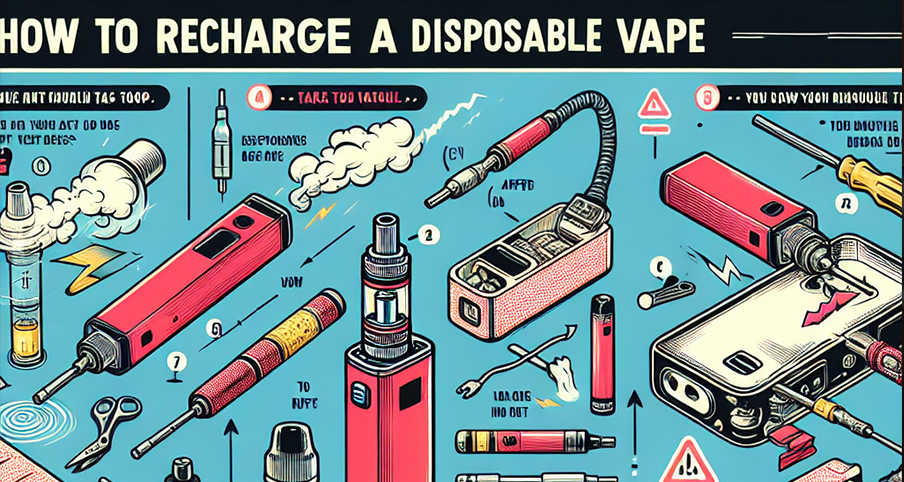Disposable vapes have revolutionized the vaping industry with their convenience and ease of use. Designed for single-use, these compact devices eliminate the need for refilling or charging, making them an ideal choice for both beginners and experienced vapers. In this article, we will explore the various types of disposable vapes, their composition, structure, and unique features. We’ll also discuss the feasibility and risks associated with attempting to recharge a disposable vape.
Understanding Disposable Vapes
Disposable vapes are small, portable electronic devices that deliver nicotine through inhaled vapor. They consist of three main components: a battery, a heating element (or coil), and a reservoir filled with e-liquid. Unlike traditional vaping devices, disposable vapes come pre-filled with e-liquid and are pre-charged, making them ready to use right out of the box.
Types of Disposable Vapes
There are several types of disposable vapes available in the market, each catering to different preferences and needs:
- Standard Disposable Vapes: These are the most common type of disposable vape. They are designed for single-use and cannot be recharged or refilled. Once the e-liquid or battery is depleted, the device is discarded.
- Rechargeable Disposable Vapes: Some manufacturers have introduced rechargeable disposable vapes, which allow users to recharge the battery. However, these devices are still single-use in terms of e-liquid; once the e-liquid runs out, the device must be disposed of.
- Flavored Disposable Vapes: Available in a wide range of flavors, flavored disposable vapes offer a diverse vaping experience. From classic tobacco to fruity and dessert-inspired flavors, there’s something for every palate.
- Nicotine Salt Disposable Vapes: These vapes use nicotine salts instead of freebase nicotine, offering a smoother throat hit and faster nicotine delivery. They are popular among former smokers seeking a more cigarette-like experience.
- High-Puff Count Disposable Vapes: Designed for heavy users, these vapes come with a larger e-liquid capacity and battery, providing more puffs per device.
Composition and Structure of Disposable Vapes
A typical disposable vape contains the following components:
- Battery: The power source of the device, usually a lithium-ion battery. The battery capacity determines how long the vape will last before it needs to be disposed of.
- Coil: The heating element that vaporizes the e-liquid. It is usually made of metal and is wrapped with a cotton wick that absorbs the e-liquid.
- E-liquid Reservoir: A container that holds the e-liquid, which is a mixture of propylene glycol (PG), vegetable glycerin (VG), nicotine, and flavorings.
- Mouthpiece: The part of the device through which the user inhales the vapor.
- LED Indicator: Some disposable vapes have an LED light that indicates when the device is in use or when the battery is low.
Features of Disposable Vapes
Disposable vapes offer several advantages that make them appealing to users:
- Convenience: No need to refill or recharge; simply use and discard.
- Portability: Compact and lightweight, easy to carry in a pocket or purse.
- Ease of Use: Simple draw-activated mechanism; no buttons or settings to adjust.
- Variety: Wide range of flavors and nicotine strengths to choose from.
- Cost-Effective: Generally cheaper than reusable vaping devices.
How to Recharge a Disposable Vape
Recharging a disposable vape is generally not recommended due to potential safety risks. However, for those curious or in extreme cases where extending the device’s life is desired, here are some steps and considerations to keep in mind.
Charging Steps
- Check the Battery Type: First, verify whether the disposable vape has a charging port. Some disposable vapes might be designed to be rechargeable, but this is relatively rare. Most disposable vapes do not support recharging, so inspect the device carefully.
- Disassemble the Device: If you decide to attempt recharging, carefully open the device casing to expose the internal battery. Be cautious not to damage other components.
- Connect the Charging Wire: Use a suitable charging wire for the battery, typically a USB cable. Carefully connect the positive and negative terminals to avoid short circuits or poor contact.
- Choose the Right Power Source: Use a stable, low-current power source for charging to reduce the risk of overheating or explosion. Avoid using high-power or fast chargers.
- Monitor the Charging Process: Always monitor the charging process to avoid overcharging. The batteries in disposable vapes do not have built-in charging protection mechanisms, making them prone to overheating or explosion.
Risks and Considerations
- Safety Risks: Self-charging can lead to battery leakage, overheating, or even explosion.
- Device Damage: Opening the device may damage internal components, rendering the device unusable.
- Legal and Warranty Issues: Unauthorized modifications may violate warranty terms and legal regulations.
- Environmental Impact: Disposable vapes are designed to not require recharging or reuse, so improper handling can harm the environment.
Conclusion
Disposable vapes have become a popular choice for many due to their simplicity and convenience. While the idea of recharging a disposable vape might seem appealing, it is not recommended due to the associated risks and challenges. Instead, users should consider purchasing rechargeable vaping devices if they seek a more sustainable and long-term solution.


